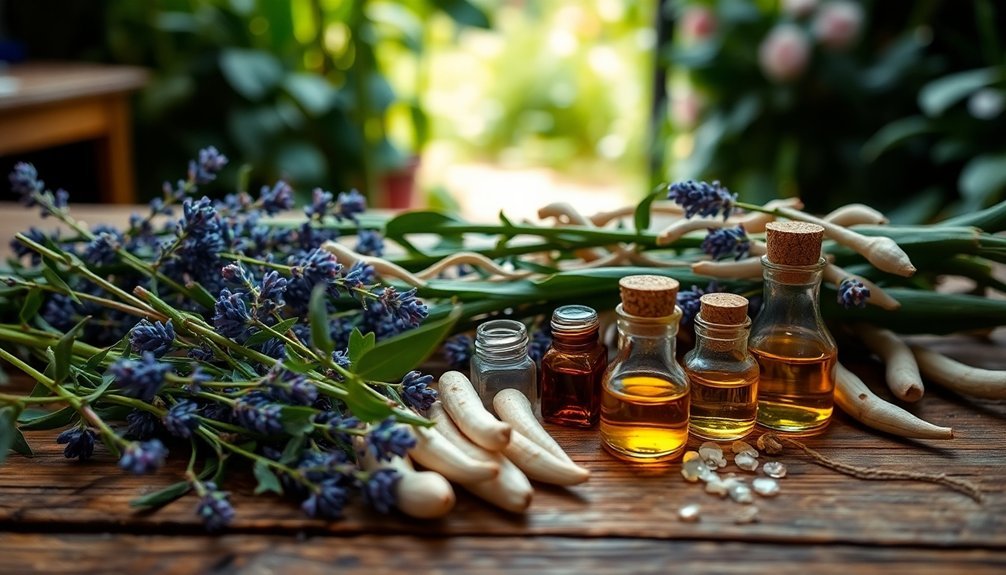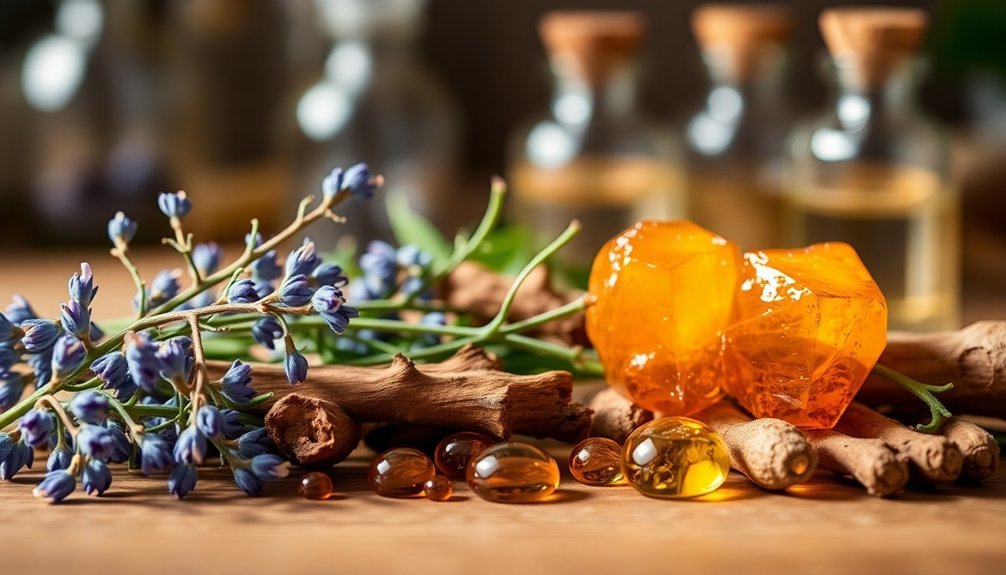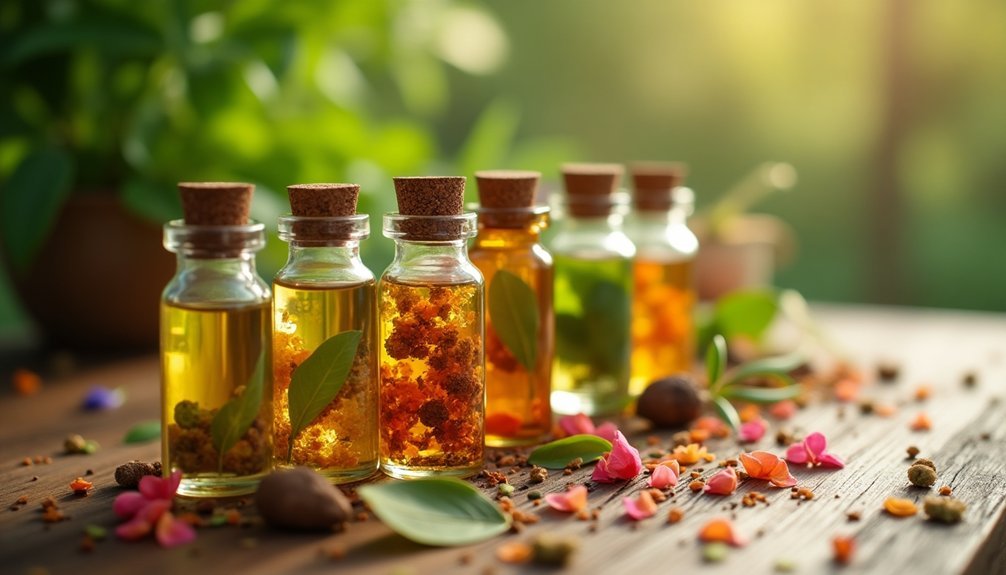Natural fixatives are essential for stabilizing your perfumes and extending their longevity. You'll find excellent botanical options in patchouli, vetiver, and sandalwood essential oils, which provide deep, anchoring base notes. Resins like benzoin, frankincense, and labdanum offer rich molecular structures that slow down evaporation rates. For ideal results, aim to use these fixatives at 3-5% concentration in your blends. The world of natural fixatives holds many more secrets to perfecting your signature scent.
Understanding Natural Fixatives in Perfumery

Natural fixatives play an essential role in perfumery by anchoring and stabilizing fragrances to maximize their longevity. When you're creating perfumes, you'll find these botanical ingredients help reduce the evaporation rate of volatile compounds while equalizing vapor pressures throughout your fragrance composition. Careful selection of fixatives is essential for achieving your desired fragrance profile and performance.
You'll typically want to keep fixatives at 3-5% of your perfume formulation, primarily in the base notes.
The most effective natural fixatives come from resinous plants, including benzoin, labdanum, myrrh, olibanum, and storax. These materials don't just stabilize your perfume – they'll also contribute their own aromatic qualities.
For instance, benzoin gives body to your blend while slowing essential oil dispersion, and labdanum adds sugary, fruity notes. Many fixatives feature high-molecular structures that help your fragrance adhere better to skin.
Essential Oils That Anchor Your Fragrances
Several powerful essential oils serve as exceptional fixatives in perfumery, working alongside traditional resins to anchor your fragrances.
If you're looking to stabilize your scent compositions, consider patchouli's rich, earthy notes or vetiver's deep, woody character – both excel at deepening lighter fragrances while preventing rapid evaporation.
You'll find sandalwood's warm, creamy profile particularly effective for fixing floral and oriental blends, while frankincense adds lasting warmth and depth to woody compositions.
Don't overlook cedarwood's balsamic aroma, which versatility anchors various fragrance types. These natural oils create a balanced fragrance profile that enhances the overall composition.
These essential oils don't just extend your perfume's life – they're actively enhancing its complexity.
They'll blend seamlessly with other notes while maintaining the fragrance's integrity, ensuring your scent remains balanced and consistent throughout its wear time.
The Power of Resins and Balsams

Prized for their rich molecular structure, resins and balsams stand as powerhouse fixatives in natural perfumery. You'll find these ancient ingredients working double duty – anchoring your volatile top notes while contributing their own distinct aromas to your blends. Modern perfume formulations typically include 11% aromatic ingredients in their compositions.
| Resin Type | Signature Scent | Best For |
|---|---|---|
| Frankincense | Warm, Resinous | Oriental & Woody |
| Benzoin | Sweet, Vanilla | Gourmand & Oriental |
| Labdanum | Deep, Leathery | Amber & Oriental |
When you're formulating your perfumes, start with small concentrations (2-5%) of these fixatives. You'll discover that frankincense prevents rapid evaporation of delicate notes, while benzoin adds a rich, smooth character to your blends. For deeper, more complex creations, try labdanum in your amber compositions or myrrh for its distinctive smoky sweetness.
Herbs and Plant Materials for Lasting Scents
Beyond resins and balsams, the botanical world offers an impressive array of herbs and plant materials that excel as fixatives.
You'll find that orrisroot, derived from iris plants, provides a woody, powdery stability while adding violet-like notes to your blends. Clary sage, with its sclareolide content, serves as an excellent alternative to costly ambergris, bringing both fixing power and complex maple-spice notes.
For a natural approach to scent longevity, you can't go wrong with lavender and chamomile.
These herbs not only stabilize your perfume but also contribute their signature calming aromas. When you're working with essential oils, consider incorporating these botanicals to create balanced, long-lasting fragrances that maintain their integrity throughout the day.
Choosing the Right Fixative for Your Blend

When selecting a fixative for your perfume blend, you'll need to contemplate both its functional properties and its impact on the overall fragrance profile.
Consider starting with benzoin if you're seeking a sweet, smooth aroma that effectively slows oil dispersion, or try labdanum for a sugary, fruity undertone.
For woody depth, sandalwood or myrrh will serve you well, while vanilla can add a creamy richness that seamlessly integrates into your composition.
If you're working with volatile top notes, frankincense or olibanum can provide stability while contributing their own piney and lemony characteristics.
Remember that fixatives typically work best at 3-5% concentration in your base notes.
You'll want to test small batches first, as these materials can considerably alter your perfume's projection and longevity.
Proper Storage and Preservation Methods
You'll need to store your botanical fixatives properly by maintaining temperatures between 50°F and 70°F and protecting them from direct sunlight to preserve their binding properties.
Keep your natural fixatives in airtight, dark-colored glass containers to prevent oxidation and maintain their potency.
When working with plant-based materials that form natural sediments, gently roll the bottle between your palms before each use rather than shaking vigorously to maintain the blend's integrity.
Temperature and Light Control
Proper temperature and light control serve as the foundation for preserving botanical fixatives in perfumes.
You'll want to maintain storage temperatures between 55-60°F (13-15°C), as warmer conditions accelerate evaporation of volatile compounds and degrade your fragrances.
Keep your perfumes in a dark, interior space away from windows, heaters, and electronic devices.
Don't store them in bathrooms, where humidity and temperature fluctuate constantly. Instead, choose a dedicated drawer or temperature-controlled cabinet that's consistently cool and dark.
You should also keep your perfumes in their original boxes for extra light protection.
Airtight Container Solutions
Selecting the right airtight containers plays an essential role in preserving your botanical perfumes' longevity and potency. Start by keeping your fragrances in their original packaging, as these bottles come with specially designed spray mechanisms and seals that protect against air exposure.
If you're using alternative containers, choose screw-top bottles or those with secure stoppers to create an airtight barrier. Don't transfer your perfumes to decorative bottles, as this can lead to contamination.
When handling your fragrances, minimize the time the bottle remains open and avoid excessive shaking, which introduces unwanted air bubbles. For extra protection, implement a double-packing method by storing your perfume bottles in their original boxes, then placing them in airtight bags or containers.
Remember to inspect your fragrances regularly for any changes in color or quality.
Handling Natural Material Sediments
Natural perfumes inevitably develop sediments over time as their botanical ingredients break down and settle. You'll notice this especially with jasmine absolute and other natural oils that tend to coagulate and darken with age.
To minimize sediment formation, you'll want to store your perfumes in a cool, dark place away from heat sources and direct sunlight. Dark-colored glass bottles offer the best protection against photodegradation.
Don't keep your perfumes in the bathroom, where heat and humidity can accelerate degradation.
Keep an eye on your perfume's appearance and scent profile. If you notice clouding or color changes, particularly in bergamot-based perfumes that may develop a dark green-brown hue, don't worry – it's a natural part of the aging process.
Regular inspection will help you monitor any changes and maintain your perfume's quality.
Mixing Ratios and Application Techniques

Creating successful perfumes depends heavily on understanding the precise ratios and techniques for mixing botanical fixatives.
You'll want to keep fixatives at 3-5% of your total fragrance composition, though this can vary based on your desired outcome. For a standard 30ml fragrance oil, you'll need about 10ml of fixative.
When applying fixatives, blend them seamlessly with base notes like vanilla and sandalwood. You're creating a matrix that traps fragrance molecules and slows their evaporation.
Remember that fixatives can decrease projection while increasing longevity, so you'll need to strike the right balance. Focus on harmonizing your fixatives with mid and top notes to maintain a cohesive scent profile.
Always adjust your ratios based on the specific fixative type and your fragrance goals.
Enhancing Fragrance Longevity Naturally
When developing long-lasting natural perfumes, botanical fixatives serve as your essential anchoring agents. These plant-based stabilizers bind with scent molecules to prevent rapid evaporation while adding depth and complexity to your fragrance.
- Choose base fixatives like sandalwood or patchouli to create a strong foundation that'll keep your top notes from dissipating too quickly.
- Layer resinous fixatives such as frankincense or myrrh to enhance the perfume's staying power and add therapeutic benefits.
- Incorporate labdanum or balsam of Peru to achieve a rich, lasting sweetness that blends seamlessly with other fragrance components.
You'll find that combining different botanical fixatives not only extends your perfume's longevity but also creates a more sophisticated scent profile with improved diffusion and character.
Frequently Asked Questions
Can Botanical Fixatives Trigger Allergic Reactions When Used in Perfumes?
Yes, you'll find that botanical fixatives can trigger allergic reactions, including skin rashes, breathing problems, and dermatitis. Common allergens include essential oils, musk, and ambergris when used in fragrances.
How Long Does It Take for Natural Fixatives to Fully Blend?
You'll need at least 24 hours for natural fixatives to start blending, but it's best to allow a full week for ideal maturation. Regular shaking during this time helps ingredients integrate completely.
Do Botanical Fixatives Change Scent Profiles During Different Weather Conditions?
Yes, you'll notice your botanical fixatives' scent profiles shift with weather changes. They'll project more strongly in warm conditions, while cold weather slows their evaporation, affecting how the fragrance unfolds on your skin.
Which Botanical Fixatives Work Best for Individuals With Oily Skin?
For your oily skin, you'll find benzoin, sandalwood, and patchouli work exceptionally well. They're naturally compatible with your skin's oils and provide excellent longevity while maintaining the fragrance's stability throughout wear.
Can Botanical Fixatives Be Used in Solid Perfume Formulations?
Yes, you can effectively use botanical fixatives in solid perfumes. They'll blend well with beeswax and carrier oils to create long-lasting fragrance balms that help anchor scents while providing moisturizing benefits to your skin.
In Summary
Now that you've learned about natural fixatives, you're ready to create longer-lasting perfumes using botanical ingredients. Remember to experiment with different ratios of resins, essential oils, and herbs until you find your perfect blend. Always store your creations properly and test small batches first. With these natural fixative techniques, you'll craft beautiful, enduring fragrances that stay true to your vision.





Leave a Reply